

Home
About Us
Allotments
Garden Equipment
Seed Suppliers
Manure Problems
Children's Pages
GLA Blog
Weather Blog
School Veg Patch
Useful Links
Guide to Identifying Garden Birds
Our garden birds are probably our closest and most readily visible wildlife neighbours, but many go unnoticed or identified.
When I was teaching I was always surprised that most of my class of 11 year olds couldn’t identify even the most common of garden birds which they saw and ignored most days. Sparrow was the name given to any smallish bird that was vaguely brown.
Then one of our cleaners commented that there was a baby magpie on the playground. The baby magpie was in fact a pied wagtail so it was clear that it wasn’t just the children who had problem identifying garden birds.
According to the 2016 RSPB Big Garden Birdwatch results the most frequent bird visitors to our garden are:
- house sparrow
- starling
- blue tit
- blackbird
- woodpigeon
- goldfinch
- chaffinch
- great tit
- robin
- long tailed tit
We are lucky enough to have all of these species visit our garden and a few more. I also love taking bird photographs and so I thought I could make good use of my collection of photos by helping anyone struggling with bird identification. With a little practise most common garden birds are easily distinguishable. Just to help along the way here are a few pointers.
If you want to increase the number of bird species visiting then one way is to vary the type of food on offer and also to place food in a variety of feeding devices.
House Sparrow
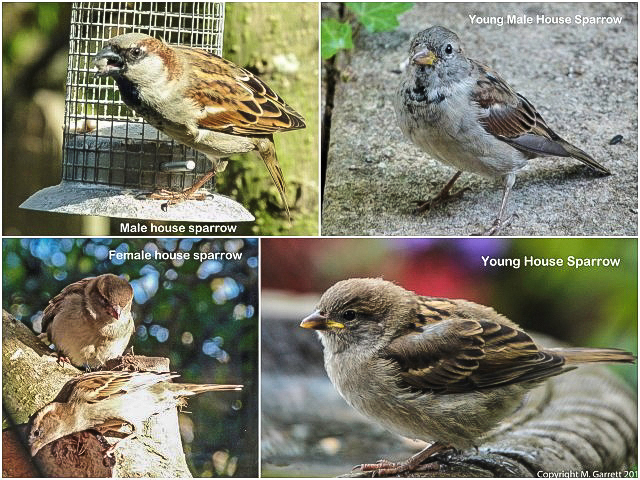
A male house sparrow is a very distinctive bird, the main identifying features of the male are:
- Dark grey cap
- Paler greyer cheeks
- Black bib (the larger area of bib, the more dominant the bird)
- Main identifying features of the female are:
- Pale stripe above the eye
Both sexes have a white wing bar
A house sparrow especially the female may be confused with dunnock, female chaffinch, tree sparrow, female or young greenfinch
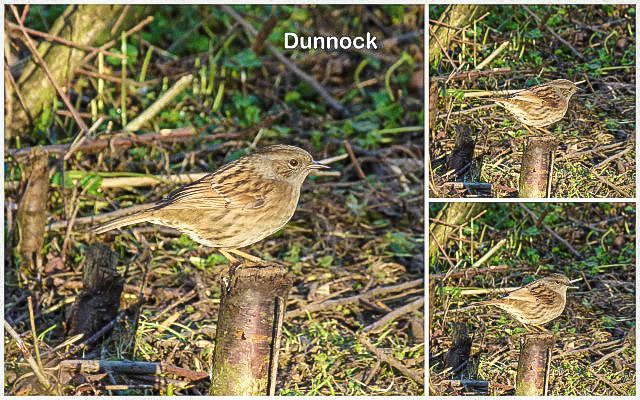
The dunnock is a much more slender bird more likely to be seen on the ground and is usually a solitary bird.
The sexes are alike and the main distinguishing features are:
- Slender beak rather than the chunky sparrow beak
- Grey head
- Pinkish legs
- No pale eyestripe
May be mistaken for a female house sparrow
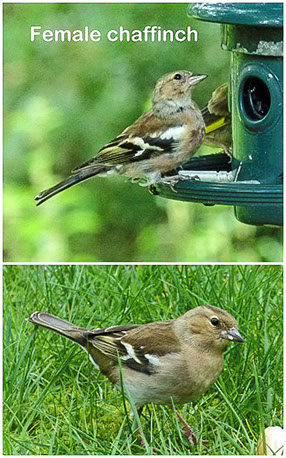
Chaffinch
The female chaffinch could be confused for a female house sparrow but is generally lighter coloured.
The main distinguishing features are:
- Distinctive white wing bars especially noticeable when flying off
The male chaffinch is much brighter than the browner female which may be mistaken for a female sparrow. One of the main noticeable features is the flash of white feathers when the bird takes off and is in flight
The main distinguishing features are:
Male:
- Grey cap and shoulders
- Pink breast and face – brighter in summer than winter months
- White patches and bars on wings
- Brown on top of its back
- Bill less stubby or parrot-like than many finches
Female
- Browner feathers overall
- White patches and bars on wings
May be confused with bullfinch, house sparrow, robin
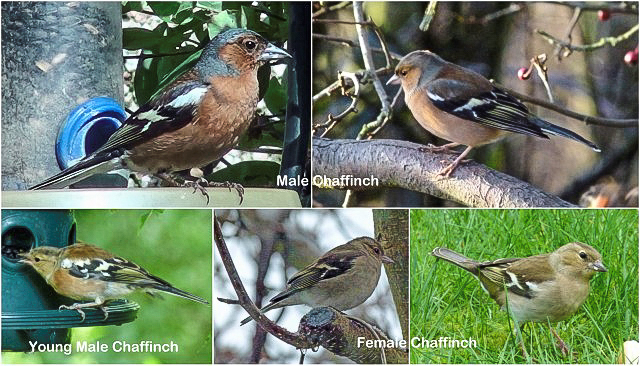
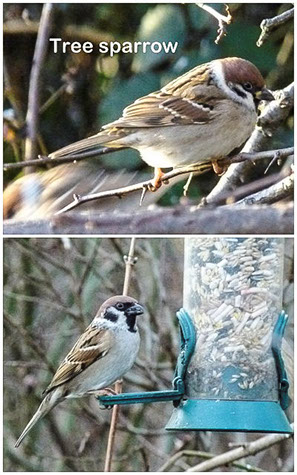
Tree Sparrow
The tree sparrow sexes are alike.
The main distinguishing features are:
- Chestnut brown cap (not grey)
- White cheek patches with black marking
- Smaller black bib
May be mistaken for a house sparrow
Greenfinch
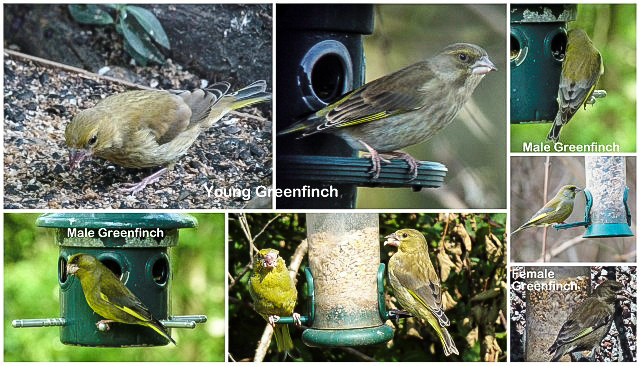
The greenfinch is a larger sturdier finch with a strong stubby looking beak.
The main distinguishing features are:
Male
- Bright green in summer especially when the sun catches its feathers
- Duller more olive green in winter
- Yellow edging to wings and tail
- Flash of yellow when it takes off
- Darker patch around eyes
- Grey on lower back
- Pink legs
Female
- Less brightly coloured
- Streaky back
- Yellow on wings and tail but not as vivid as the male
- Pink legs
- Young bird
- Similar to female
- Streaks more apparent
May be confused with house sparrow
Bullfinch
 Bullfinches are stockier looking birds with strong looking short beaks. The female is less colourful than the male.
Bullfinches are stockier looking birds with strong looking short beaks. The female is less colourful than the male.
The main distinguishing features are:
Male:
- Bright pink almost red underparts and cheeks
- Black cap
- Black ends to wings
- Black tail
- Grey back
- White wing bar
Female
- Pale pinkish fawn underparts and cheeks
- Black cap
- Dark grey ends to wings
- Dark grey tail
- Pinkish brown back
- White wing bars
May be confused with chaffinch, robin
Goldfinch
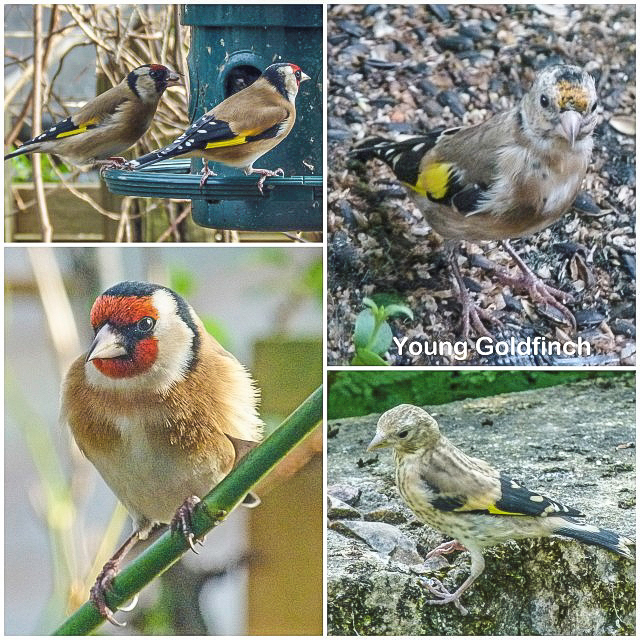 Goldfinches are smaller more delicate looking finches. Male and female a have the same unmistakable markings.
Goldfinches are smaller more delicate looking finches. Male and female a have the same unmistakable markings.
The main distinguishing features are:
- Red face
- White cheeks and ‘chin’
- Top of the head and back of the neck is black
- Light brown toffee coloured back and each side of chest
- White underparts
- Ends of wings are black with white markings
- A band of yellow on the edge of the wings
- Pink legs
Robin
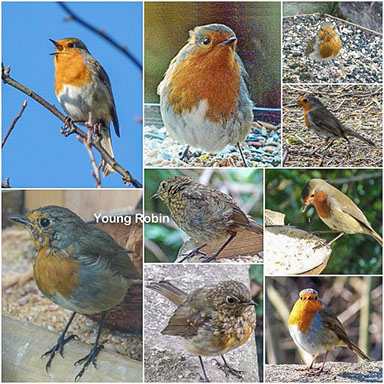
Male and female robins have the same markings and colouration. The robin is often portrayed as a round chubby bird but it can appears sleek or rounded depending on how fluffed up its feathers are.
The main distinguishing features are:
- Orange red face and breast with grey edging
- Pale brown back and cap
- White lower underparts
- Slender legs
- On the ground often makes lots of flicking/bobbing movements
- Young bird
- Speckled - decreasing in number as the bird gets older
- Red breast gradually develops usually starting from the lower chest.
May be confused with bullfinch, male chaffinch
Blackbird
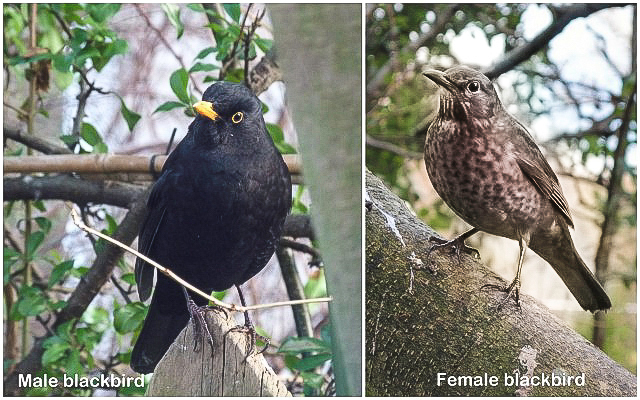 The male blackbird is true to its name is black but the female is brown.
The male blackbird is true to its name is black but the female is brown.
The main distinguishing features are:
Male:
- Black feathers
- Yellow beak
- Yellow eye ring
Female:
- Brown feathers
- Slightly speckled breast
- Brownish beak
- Young blackbirds are brown and have more distinct speckles.
Females blackbirds may be confused with song thrush
Song Thrush
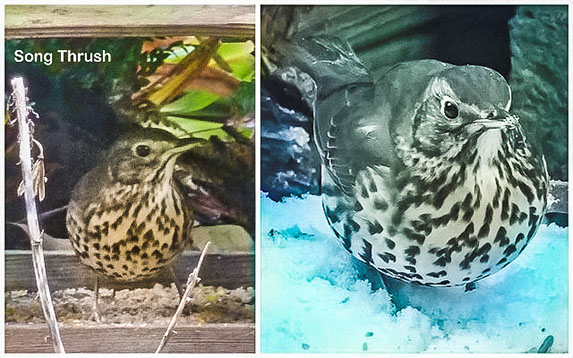
Male and female song thrushes are very similar
The main distinguishing features are:
- Pale brown/buff coloured chest
- Distinct speckles which are vaguely arrow-shaped pointing upwards
Starling
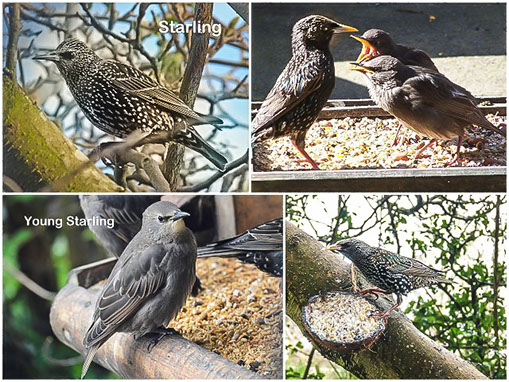 Male and female starlings are very much alike. Unless you can see them side by side the slight differences are not easily noticeable. Starlings walk rather than hop or bounce like a blackbird.
Male and female starlings are very much alike. Unless you can see them side by side the slight differences are not easily noticeable. Starlings walk rather than hop or bounce like a blackbird.
The main distinguishing features are:
- Noisy and quarrelsome
- Blackish body feathers
- Long beak – yellow in summer
- Brown grey beak in winter
- White speckles
- In spring feathers shine blue, green and purple
- Brown markings along edges of flight feathers
Young bird
- Brownish feather becoming brown-grey
- Speckled underparts
- Into first winter they are a mixture of adult and juvenile feather colouring.
Young birds may be mistaken for a female blackbird.
Blue Tit
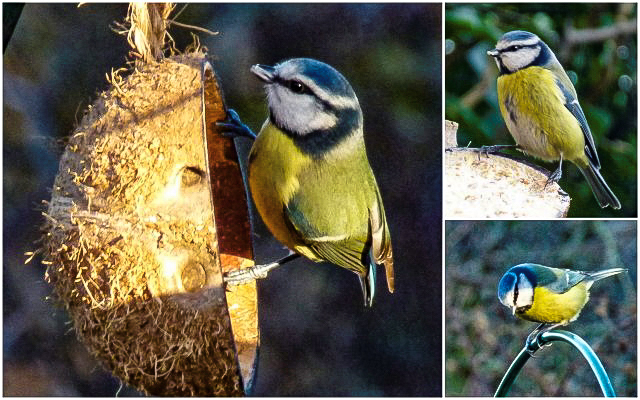 The blue tit a small lively bird that will often be seen hanging upside down from twigs and feeders. The sexes are alike and the main distinguishing features are:
The blue tit a small lively bird that will often be seen hanging upside down from twigs and feeders. The sexes are alike and the main distinguishing features are:
The main distinguishing features are:
- Blue wings
- Blue cap
- Blue tail
- Yellow front
- Greenish back
- White cheeks
- Black mask around eyes
A blue tit may be confused with a great tit
Great Tit
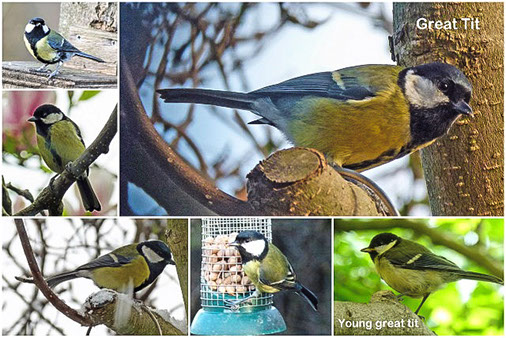 The great tit is larger (about the size of a sparrow) than the blue tit. Both sexes are similar, however the black stripe down the chest of the female is narrower.
The great tit is larger (about the size of a sparrow) than the blue tit. Both sexes are similar, however the black stripe down the chest of the female is narrower.
The main distinguishing features are:
- Black cap that extends over the eyes
- Black neck and throat
- Black stripe down chest
- Yellow underparts
- White cheeks
- White bar on wings
The great tit may be mistaken for a blue tit
Long Tailed Tit
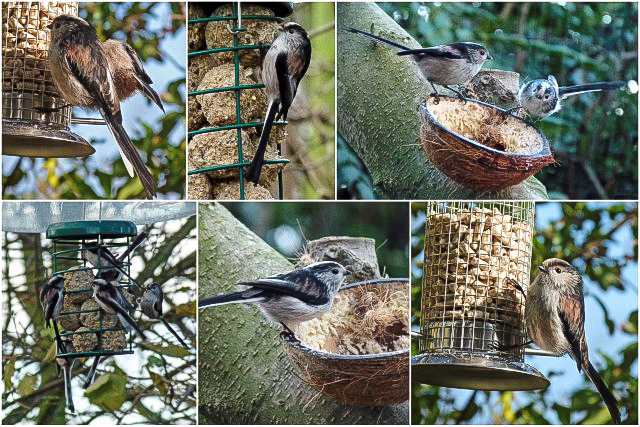
The long tailed tit is a tiny bird with a very long tail. It has the general appearance of a small pink powder puff. Male and females are not noticeably different.
The main distinguishing features are:
- Very long tail – about half of the bird’s total length.
- White stripe on the top of its head which extends down the back of the neck with a black stripe to either side giving almost a badger-like appearance
- Pink shoulders
- Underparts white changing to pink towards the tail
- Very small beak
- Red rings around the eyes
- Black wings
- Black tail with white edges
- Dark almost black legs.
Wood Pigeon
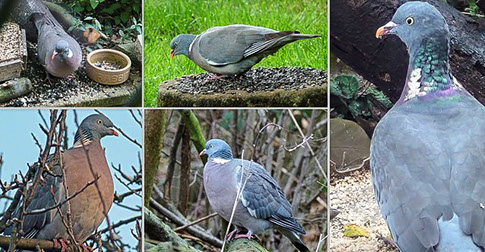
Wood pigeons are very large birds that seems to be overweight. It is very noisy when it takes off as it claps its wings together above its head. Male and female birds have the same colouring.
The main distinguishing features are:
- Small head in comparison to its body
- Grey back and head
- Pinkish underparts
- Colourful green, pink and purple patch on the back of its head
- White patches on ‘shoulders
- White markings on wings
- Pink legs
- Pinkish curved beak
- Yellow ring around the eye
Young birds are not as brightly coloured and don’t have the white patch on their necks so may be confused with the rarer Stock Dove
Wood pigeon may also be mistaken with feral pigeons
Stock Dove
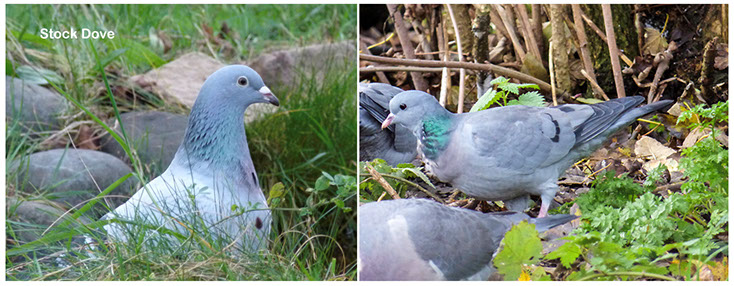
Male and female stock doves are very much alike.
The main distinguishing features are:
- Bluish grey feathers
- Breast slightly pinkish
- Neck shines green, blue and purple
- No white neck patch
- No yellow ring around the eyes
- Black markings on the wings
May be mistaken for wood pigeons or feral pigeons
Collared Dove
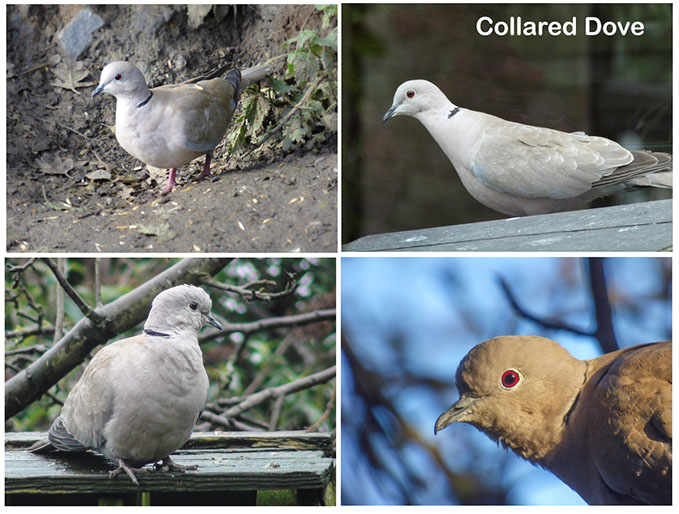
Male and female collared doves are very much alike.
The main distinguishing features are:
- Pale grey/fawn feathers
- Black half collar with white border round back of the neck
- Darker coloured wing tips
- Pink legs
- Red eyes
- Whitish ring around eyes
- Black bill
In young birds the collar may be missing or less distinct
Our Plot at Green Lane Allotments Blog | A Gardener's Weather Diary | School Vegetable Patch Website
© Our Plot on Green Lane Allotments - Please email me if you wish to use any of this site's content